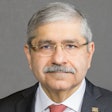For most people, planning for the upcoming 2000 RSNA meeting means arranging flights and hotels, preparing presentations, trolling for after-conference activities, and generally gearing up for an intense week.
But for many international clinicians, particularly in developing nations, just getting to the RSNA meeting -- or to any of the several hundred other radiology conferences around the globe -- is a feat unto itself. But international clinicians aren’t left completely to their own devices, as medical imaging associations and vendors offer various scholarships and travel aid.
For those looking to attend the world's largest medical imaging meeting, the Radiological Society of North America has the International Visiting Scholar Program. One scholar is selected each year to attend the annual conference in November. The RSNA will provide travel funds to Chicago and hotel accommodations, as well as a per diem allowance.
The British Institute of Radiology offers the BIR Travel Bursaries, as well as the Nic McNally Prize. The Travel Bursaries are funds dedicated to helping BIR members, 35 years or older, attend a national or international meeting where he or she will present a paper. The Nic McNally Prize is given annually to both BIR members and non-members under age 35, who can use the funds to either attend a scientific meeting or visit a facility in another country.
Doctors from developing countries are encouraged to submit a paper for possible presentation at the 2001 European Congress of Radiology conference in Vienna. If the paper is accepted, the ECR will waive the presenter's registration fees, foot the bill for hotel accommodations, and provide a per diem. The deadline for submission is September 18, 2000.
"The number of people who can be supported is limited," said Elke Moller of the ECR. "As the applications will be considered by the date of receipt, they should be sent as soon as possible."
The Radiology Education Fund of India awards four scholarships a year to encourage young radiologists to attend conferences. In 1998 and 1999, Indian clinicians attended either the RSNA or the Indian Radiology Imaging Association meeting with support from the fund.
While the American Roentgen Ray Society does not offer explicit travel awards, it does sponsor two scholarships that can include conference attendance. Through the ARRS Annual Scholarship Program, two U.S radiologists are chosen each year to receive $120,000 in funding. A portion of that award can be used for conference attendance expenses as long as it contributes to the clinician’s stated research goals. Winners of the second ARRS program, the Residents in Radiology Awards, are invited to the ARRS annual meeting to present their research. The 2001 conference will be held in Seattle, WA.
For Canadian clinicians, the Society of Nuclear Medicine has a Fellowship Program for Research in conjunction with DuPont Pharmaceuticals. Complimentary registration and expenses will be provided to the recipient in order to attend the society’s annual meeting, which will be in Toronto in 2001.
The International Organization for Medical Physics hosts a travel aid program for their members in developing countries. Registration fees for the annual meeting, as well as $500 in travel expenses, are given to two delegates from Latin America, Africa, Europe, Middle East, and Asia.
The Royal College of Radiologists in the U.K. administers two traveling fellowships. One is the Kodak Radiology Fund Scholarship, which awards up to $7,500 a year to one senior radiologist for travel and educational expenses. The college also administers the Mallinckrodt Medical Radiology Travelling Scholarship, which allows clinical radiology trainees or junior consultants to visit the Mallinckrodt Medical Institute of Radiology in St. Louis, MO.
For general information on possible funding opportunities, try the Radiation Research Society, which offers a link to various grant and fellowship programs. The Research Group on Radiation Protection, part of the University of Malaga in Spain, provides a link to radiology organizations worldwide. The University of Indiana’s department of radiology offers a list of possible grant sources, such as the National Institutes of Health and the Whitaker Foundation.
Finally, keep an eye out for the 2001 launch of the Education and Research Fund, sponsored by the American Institute of Ultrasound in Medicine. The fund will award several grants of $10,000 or less every year to organizations that are AIUM members, and "have demonstrated their dedication to the advancement of ultrasound in medicine and research." Currently, the AIUM offers five free, one-year memberships to physicians in developing countries. In addition, 100 free subscriptions to the Journal of Ultrasound in Medicine are given to medical libraries in developing nations.
August 2000
Copyright © 2000 AuntMinnie.com



















